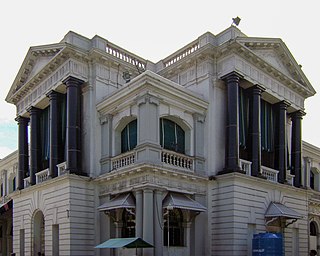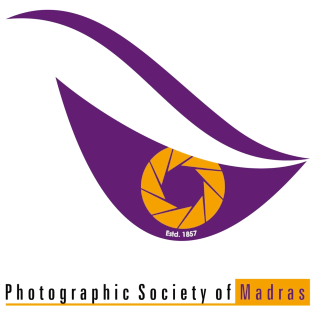Related Research Articles

Chennai, formerly known as Madras, is the capital city of the Indian state of Tamil Nadu. The state's largest city in area and population as well, Chennai is located on the Coromandel Coast of the Bay of Bengal, and is the most prominent cultural, economic and educational centre of South India.

Fort St. George is a fortress in the coastal city of Chennai, India. Founded in 1639, it was the first English fortress in India. The construction of the fort provided the impetus for further settlements and trading activity, in what was originally an uninhabited land. Thus, it is a feasible contention to say that the city evolved around the fortress. The fort currently houses the Tamil Nadu legislative assembly and other official buildings.

The University of Madras is a public state university in Chennai, Tamil Nadu, India. Established in 1857, it is one of the oldest and among the most prestigious universities in India, incorporated by an act of the Legislative Council of India under the British government.

The Connemara Public Library at Egmore in Chennai, Tamil Nadu, India, is one of the four National Depository Libraries which receive a copy of all books, newspapers and periodicals published in India. Established in 1896, the library is a repository of century-old publications, wherein lie some of the most respected works and collections in the history of the country. It also serves as a depository library for the United Nations. It is located in the Government Museum Complex on Pantheon Road, Egmore, which also houses the Government Museum and the National Art Gallery.

The Asiatic Society is a government of India organisation founded during the Company rule in India to enhance and further the cause of "Oriental research", in this case, research into India and the surrounding regions. It was founded by the philologist William Jones on 15 January 1784 in a meeting presided over by Justice Robert Chambers in Calcutta, the then-capital of the Presidency of Fort William.

The Greater Chennai Corporation, formerly known as the Corporation of Madras (1688-1996) and Corporation of Chennai (1996-2016), is the civic body that governs the city of Chennai in the Indian state of Tamil Nadu. Inaugurated on 29 September 1688, under a royal charter issued by King James II of England on 30 December 1687 as the Corporation of Madras, it is the oldest municipal body of the Commonwealth of Nations outside Great Britain. It is among the oldest municipalities in Asia after Daman Municipality, which was established in 1588. It is the largest municipal corporation in Tamil Nadu with an area of 426 km2. It is headed by a mayor, who presides over 200 councillors, each of whom represents one of the 200 wards of the city. It is the second oldest civic corporation in the world after the City of London.

Triplicane, known in the vernacular as Thiruvallikeni, is one of the oldest neighbourhoods of Chennai, India. It is situated on the Bay of Bengal coast and about 0.6 km (0.37 mi) from Fort St George. The average elevation of the neighbourhood is 14 metres above sea level.

Nungambakkam is a locality in downtown Chennai, India. The neighborhood abounds with multi-national commercial establishments, important government offices, foreign consulates, educational institutions, shopping malls, sporting facilities, tourist spots, star hotels, restaurants, and cultural centers. Nungambakkam is also a prime residential area in Chennai. The adjoining regions of Nungambakkam include Egmore, Chetpet, T. Nagar, Kodambakkam and Choolaimedu.

The Government Museum, Chennai, or the Madras Museum, is a museum of human history and culture located in the Government Museum Complex in the neighbourhood of Egmore in Chennai, India. Started in 1851, it is the second oldest museum in India after the Indian Museum in Kolkata. It is particularly rich in archaeological and numismatic collections. It has the largest collection of Roman antiquities outside Europe. Among them, the colossal Museum Theatre is one of the most impressive. The National Art Gallery is also present in the museum premises. Built in Indo-Saracenic style, it houses rare European and Asian painting of renowned artists, including that of Raja Ravi Varma. It had 0.6 million visitors in 2018. It has the richest collections of bronze idols, 500 of them dating to 1000 BCE, in Asia.
Puzhal is a Northwestern residential town in Chennai district in the Indian state of Tamil Nadu. Puzhal is located on the banks of Puzhal Lake. The town is known for Puzhal central prison.

Madras Day is a festival organised to commemorate the founding of the city of Madras in Tamil Nadu, India. It is celebrated on 22 August every year, 22 August 1639 being the widely agreed date for the purchase of the village of Madraspatnam or Chennapatnam by East India Company factors Andrew Cogan and Francis Day from Damarla Venkatadri Nayaka, the viceroy of the Vijayanagar Empire.

Anna Salai, formerly known as St. Thomas Mount Road or simply Mount Road, is an arterial road in Chennai, India. It starts at the Cooum Creek, south of Fort St George, leading in a south-westerly direction towards St. Thomas Mount, and ends at the Kathipara Junction in Guindy. Beyond the Kathipara Junction, a branch road arises traversing westwards to Poonamallee to form the Mount-Poonamallee Road while the main branch continuing southwards to Chennai Airport, Tambaram and beyond to form Grand Southern Trunk Road. Anna Salai, which is more than 400 years old, is acknowledged as the most important road in Chennai city. The head offices of many commercial enterprises and public buildings are located along Anna Salai. It is the second longest road in Chennai, after EVR Periyar Salai.
The Egmore Eye Hospital, officially the Regional Institute of Ophthalmology and Government Ophthalmic Hospital, is a public eye hospital in Chennai, India. Considered the oldest eye hospital in Asia, the institute was established in 1819 and is the second oldest hospital of its kind, next only to the Moorfields Eye Hospital in the United Kingdom.

George Town is a neighbourhood in Chennai, Tamil Nadu, India. It is near the Fort Saint George, Chennai. It is also known as Muthialpet and Parry's corner. It is an historical area of Chennai city from where its expansion began in the 1640s. It extends from the Bay of Bengal in the east to Park town on the west. The Fort St. George is on the south, to Royapuram in the north. The Fort St. George houses the Tamil Nadu Legislative Assembly and the Secretariat. The High court of Tamil Nadu at Chennai, Dr. Ambedkar Law College, Stanley Medical College and Hospital are located here.

The Anna Centenary Library (ACL) is an established state library of the Government of Tamil Nadu. It is located at Kotturpuram, Chennai. It is built at a cost of ₹172 crores. It is named after a former chief minister of Tamil Nadu, C. N. Annadurai. It was opened by the then Chief Minister of Tamil Nadu M. Karunanidhi. The average number of persons who visited the library between January and October 2011 is around 26,500, compared to the monthly average of 20,000 in 2010.

Alliance Française of Madras is a Franco-Indian non-profit association in Chennai, India, that works to promote the cultural relations between India and France in Tamil Nadu and also with a mission to teach the French language to the people in the region. It was formed in 1953.
Chennai, with historically rich records dating at least from the time of the Pallavas, houses 2,467 heritage buildings within its metropolitan area (CMA), the highest within any Metropolitan Area limit in India. Most of these buildings are around 200 years old and older. Some of them are Chennai Central, Chennai Egmore, Ripon Building, Senate House, Bharat Insurance Building, and so forth. Chennai is home to the second largest collection of heritage buildings in the country, after Kolkata. The official list of heritage buildings was compiled by the Justice E. Padmanabhan committee. The Tamil Nadu Assembly passed the Heritage Commission Act in 2012 to preserve old heritage structures.

The Photographic Society of Madras, also known as PSM, is a photographic society based in Chennai city of India. Founded in 1857, it is the oldest photographic society in India and one of the oldest in the world. PSM was founded in 1857, with the objective of promoting the Art and Science of Photography. The Society was renamed as Madras Amateur Photographic Society in the mid-1880s and later it reverted to its original name and continues to be known as Photographic Society of Madras. The Photographic Society of Madras is registered under the Tamil Nadu Societies Registration Act 1975. PSM organizes programs including, photo-walks, photo-tours, classes, workshops, salons and exhibitions, on most weeks of the year. Membership is open to anyone with an interest in photography.

Royapettah is a neighbourhood of Chennai, India.
References
- ↑ Srinivasachari, C.S. (1839). History of the City of Madras. Madras: P. Varadachary & Co. p. 216.
- ↑ Wagoner, Phillip B. (2003). "Precolonial Intellectuals and the Production of Colonial Knowledge". Comparative Studies in Society and History. 45 (4): 783–814. doi:10.1017/S0010417503000355. S2CID 145060460.
- ↑ Anon. (1828). "Review-Transactions of the Literary Society of Madras". The Asiatic Journal and Monthly Register for British India and Its Dependencies. 26: 332–333.